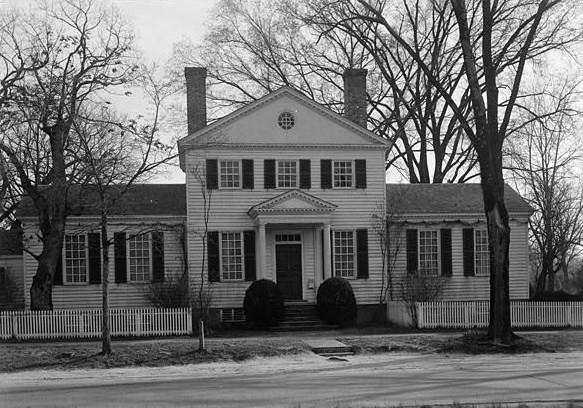James Semple House
Introduction
Text-to-speech Audio
Images
James Semple House, U. S. Government Work (public domain)

Backstory and Context
Text-to-speech Audio
The house was built for Colonel William Finnie, who served as quartermaster general of the Southern Department during the American Revolution. Judge and College of William and Mary professor of law James Semple purchased the house in 1800. Future tenth president of the United States John Tyler (1790-1862), who was related to the Semples, lived here when he was a student at the College of William and Mary from 1802 to 1807.
The house is a framed structure with exterior clapboarding, consisting of a two-story center section flanked by one-story wings. It sits on the south side of Francis Street on the eastern end of Williamsburg, between Blair Street and Waller Street. The center section of the house features two chimneys and a pedimented gable roof. The two single-story wings also have gable roofs. The Classical Revival style of the house also invokes the Palladian style, and is an example of tripartite houses built throughout the South in the early American republic.
Originally the center section contained a large salon with fireplace, which during the nineteenth century was divided into smaller spaces. The east wing served as a dining room and the west wing as a drawing room. Behind the east chimney is a winding staircase similar to the staircase at Monticello, which reaches the two bedrooms on the upper story of the center wing.
During the nineteenth century, the house had several owners. The Colonial Williamsburg Foundation acquired it in 1932, one of its first acquisitions. The foundation restored the house by rebuilding the chimney and front steps, removing a wing dating to the early nineteenth century, and replacing other altered details.
Sources
Dillon, James. James Semple House, National Register of Historic Places Inventory - Registration Form. October 16th 1974. Accessed May 17th 2020. https://www.dhr.virginia.gov/wp-content/uploads/2018/04/137-0033_JamesSempleHouse_1974_Nomination_NHL.pdf.
Historic American Buildings Survey. Semple House, Francis Street, Williamsburg, Independent City, VA, Library of Congress. Accessed May 17th 2020. https://loc.gov/pictures/item/va0650/.
National Park Service. Semple, James, House [archived web page], National Historic Landmark Program. June 6th 2011. Accessed May 17th 2020. https://web.archive.org/web/20110606155036/http://tps.cr.nps.gov/nhl/detail.cfm?ResourceId=1038&ResourceType=Building.
Virginia Department of Historic Resources. James Semple House, Virginia's National Historic Landmarks. April 9th 2019. Accessed May 17th 2020. https://www.dhr.virginia.gov/historic-registers/137-0033/.
https://en.wikipedia.org/wiki/James_Semple_House#/media/File:Semple_House,_Francis_Street_(Williamsburg,_Virginia).jpg
